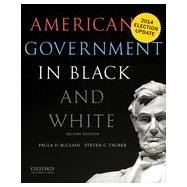Concise, affordable, and engaging, American Government in Black and White, Second Edition, 2014 Election Update, is a unique introduction to American government that uses racial and ethnic equality as its underlying theme. Authors Paula D. McClain and Steven C. Tauber address issues of inequality in major facets of government, including the U.S. Constitution, key American political institutions and instruments of political behavior, and the making of public policy. Engaging the original voices of racial and ethnic actors in our nation's history, they show students how to measure and evaluate the importance of equality in America, from its founding up to today.
FEATURES
* Three kinds of text boxes that help students develop empirical and qualitative analytical abilities: "Measuring Equality," "Evaluating Equality," and "Our Voices"
* Vignettes, illustrations, and case material that connect America's past and present
* Running glossary definitions, thematic chapter conclusions, probing review questions, and annotated additional readings highlighting writings by and about racial and ethnic minorities








